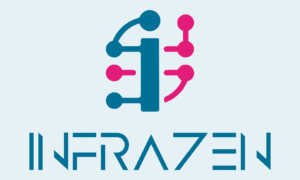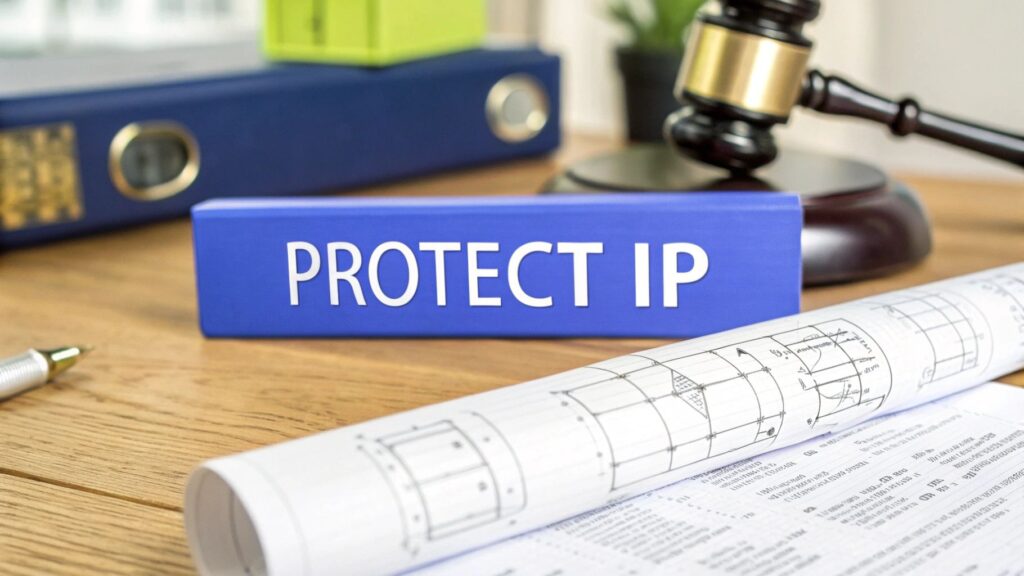So, you’re wondering how to protect your intellectual property. The short answer? There's no single silver bullet. It’s about building layers of defence using a smart mix of legal registrations, solid agreements, and proactive security. Think of it less as a single action and more as a complete system designed to keep your creative assets safe.

What Does an IP Protection Roadmap Actually Look Like?
Protecting your IP isn't just about damage control after someone has stolen your work. It's about building a fortress around your most valuable assets right from the start. Whether it's a groundbreaking product design, a memorable brand identity, or your own proprietary code, these creations are serious business assets. They need a deliberate and organised protection strategy.
This guide will walk you through the core pillars of a strong IP strategy. Think of it as a clear map for the journey ahead, showing how each element works together to create a powerful defence for your work.
The Four Pillars of IP Protection
A truly robust strategy weaves together several key methods. Each one is designed to tackle a different kind of risk, from legal showdowns to sneaky digital threats.
-
Formal Legal Registration: This is where you officially plant your flag. Formally registering things like patents, trademarks, and copyrights gives you the strongest possible legal footing to fight infringement. It's your public claim of ownership.
-
Rock-Solid Legal Agreements: Contracts are your first line of defence in business dealings. Non-Disclosure Agreements (NDAs), confidentiality clauses, and licensing agreements create a legal shield, giving you control over how employees, partners, and clients can (and can't) use your IP.
-
Smart Cybersecurity: Let's face it, we live in a digital world. Your IP is constantly exposed to online threats. Things like encryption, secure access controls, and regular security check-ups are non-negotiable for preventing data breaches and digital theft.
-
A Culture of Awareness: Protection goes beyond just tech and lawyers. You need to build a culture where every single person on your team understands why IP is valuable and what their role is in protecting it. This creates an alert and responsive internal defence system that technology alone can't provide.
The best IP strategies are always proactive, not reactive. They’re about thinking ahead, anticipating threats, and setting clear, enforceable boundaries before a problem ever gets the chance to happen.
To help you get a clear picture of how these elements fit together, the table below summarises the fundamental methods for protecting your creative work.
Key Methods to Protect Intellectual Property
This table provides a quick overview of the fundamental strategies for safeguarding your IP.
| Method | Description |
|---|---|
| Legal Registration | Officially registering patents, trademarks, and copyrights to establish legal ownership and exclusive rights. |
| Legal Agreements | Using contracts like NDAs and licensing deals to legally bind third parties and control IP usage. |
| Cybersecurity | Implementing digital security protocols to protect IP from hacking, data breaches, and unauthorised access. |
| IP-Aware Culture | Training staff and establishing internal policies to make IP protection a shared responsibility. |
Using this structure helps you see the bigger picture and build a comprehensive plan to protect your intellectual property from all angles.
Making Your IP Official with Registration
While conversations and handshake deals are part of the creative process, they mean very little when it comes to legally protecting your intellectual property. To do that, you need to make it official. Think of registration as moving from a casual understanding to a public, legally binding declaration of ownership. This isn't just about paperwork; it's about building a fortress around your ideas, giving you the exclusive right to use, sell, or license your creations.
Once your IP is registered, it becomes a tangible asset on your balance sheet. More importantly, it gives you clear, enforceable rights if someone tries to copy or steal your work. Without it, you’re left with much weaker, harder-to-prove protections that can be incredibly difficult to defend.
Navigating the UK Registration Maze
In the UK, the Intellectual Property Office (IPO) is your port of call. And you won't be alone. The demand for IP protection is huge—in May 2025 alone, the IPO handled over 2,000 patent applications, more than 12,000 trademark applications, and over 3,000 design applications. You can dig into the numbers yourself in the government's monthly statistics on patents, trademarks, and designs.
You'll generally be dealing with three main types of registration:
- Patents: For inventions, new products, or innovative processes.
- Trademarks: For brand names, logos, and slogans that define your identity.
- Registered Designs: For the appearance of a product—its shape, colours, patterns, and texture.
Each has its own process, cost, and timeline. A UK trademark application, for example, can often be turned around in about four months if there are no objections. A patent, on the other hand, is a much heavier lift, often taking several years to get approved.
Don't let the bureaucracy put you off. The secret is to be methodical. Start by pinpointing exactly what you need to protect and which category it fits into. So many people rush this part and end up with a rejected application.
A creative agency, for instance, might need to trademark its new company name and logo. A product designer would focus on registering the unique shape and look of a new piece of furniture. Getting this distinction right from the start is the foundation of a solid IP strategy.
Prioritising Your Registrations on a Budget
Let’s be realistic: few businesses have the cash to register every single creative asset. The real skill is figuring out which pieces of IP have the most commercial value and are worth the investment in formal protection.
Start by asking a few tough questions:
- What’s most central to our brand identity? This is almost always your company name or main logo. Protecting this should be your top priority.
- Which creation has the biggest potential to make money? If you've designed a product you plan to manufacture at scale, registering its design is a no-brainer.
- What gives us a unique edge over competitors? If you’ve developed a new software process that makes your studio radically more efficient, a patent might be worth the time and expense.
Take a small animation studio as an example. They might have hundreds of character sketches, but their most valuable IP is the studio's brand name and the lead character from their main series. Their smart move is to trademark the brand and register the design of that key character first, before even thinking about secondary assets. This focused approach ensures their limited budget is spent where it delivers the most powerful legal shield.
Thinking Beyond National Borders
Once you’ve got your UK registrations sorted, it’s time to look at your international ambitions. A UK trademark only protects you within the United Kingdom. If you have clients in Europe or the US, or plan to expand there, you’ll need broader coverage.
This is where systems like the Madrid System for trademarks become incredibly useful. It lets you file a single application to seek protection in up to 130 countries. While it's convenient, it's a strategic decision, not an automatic one. International protection is more expensive and complex, so it needs to align with your business growth plans.
There’s no point paying to protect your IP in countries where you have no commercial interests. Instead, build your portfolio piece by piece, expanding your legal shield as your business footprint grows across the globe.
Using Legal Agreements as Your Shield
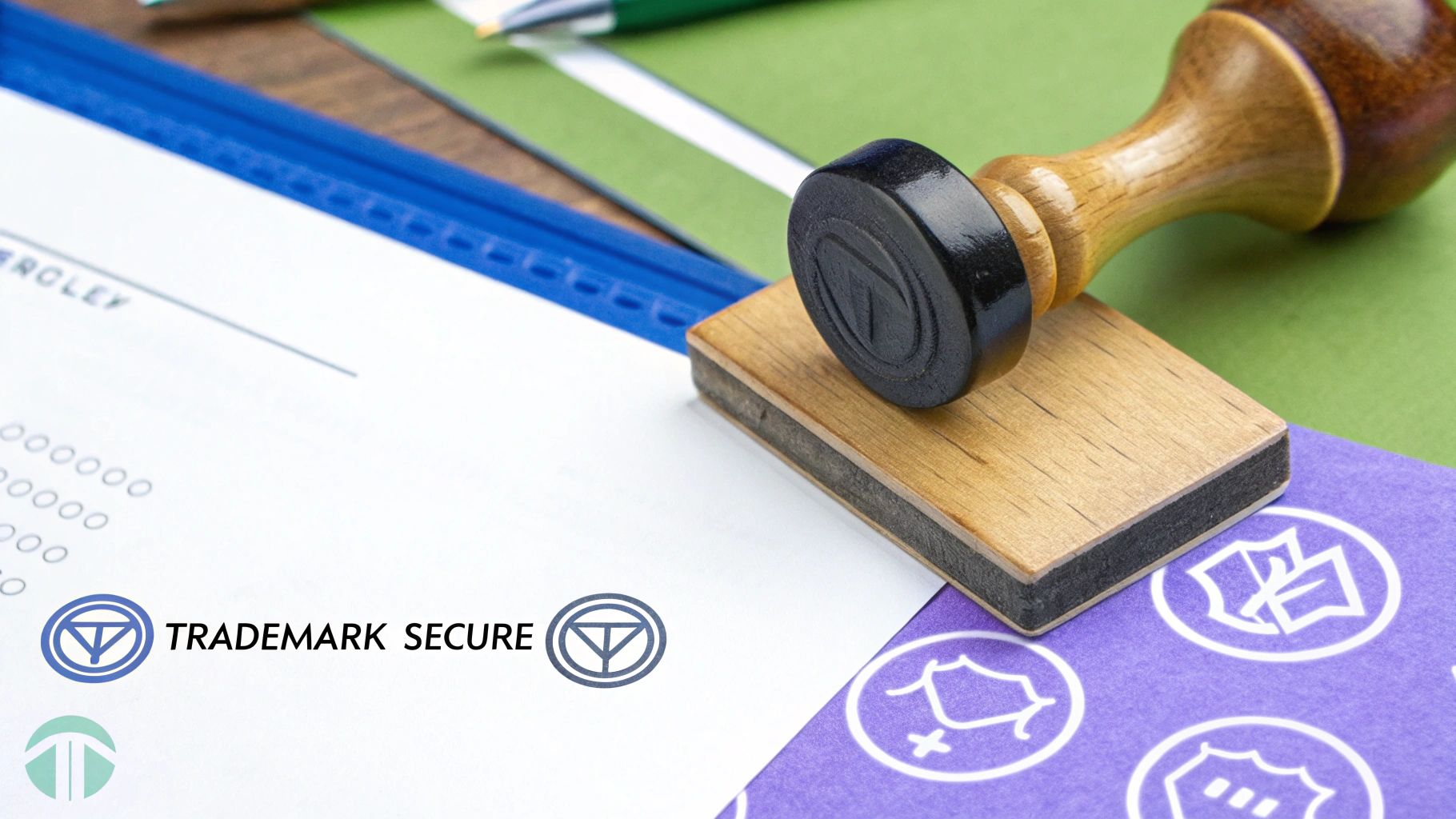
While formal IP registration is your public claim of ownership, legal agreements are your first line of private defence. They are the practical, day-to-day tools that give you real control over your creative work by setting clear, enforceable rules for anyone you collaborate with.
Think of them as the operating manual for your IP.
These contracts are absolutely essential when you're working with freelancers, onboarding new team members, or bringing in external partners. If you skip this step, you’re relying on trust alone—and trust, unfortunately, offers zero legal protection when a dispute arises. A solid agreement is proactive, not reactive. It builds a powerful shield around your most valuable assets from day one.
The Essential Contracts in Your Toolkit
For any creative business, a few agreements are simply non-negotiable. They establish legally binding obligations that stop your hard work, ideas, and trade secrets from walking out the door.
Your core arsenal should include:
- Non-Disclosure Agreements (NDAs): Before you even think about sharing sensitive project details with a potential contractor or partner, get an NDA signed. It’s a simple document that legally binds them to keep your confidential information private. No exceptions.
- Confidentiality Clauses in Employment Contracts: These are vital for protecting your internal processes, client lists, and unreleased work. This ensures that even after an employee moves on, your trade secrets remain yours.
- Client Service Agreements: This is where you clearly define who owns the final delivered work and, just as importantly, any preliminary concepts. A well-worded clause here prevents future arguments over who has the right to use what.
- Licensing Agreements: If you allow others to use your IP—like a character design, a photograph, or a piece of software—a licensing agreement sets the exact terms. It covers usage rights, duration, and any royalty payments.
A common mistake I see is businesses pulling a generic, one-size-fits-all template off the internet. A contract's true strength lies in its specificity. A photographer's licensing agreement needs to cover different risks than a software developer's. Your agreements must reflect the unique realities of your business.
Negotiating Terms That Truly Protect You
The real power of any contract is hidden in the details. When you're negotiating, it's not just about getting a signature on the dotted line. It's about making sure the terms are airtight and genuinely protect your interests.
Here are the critical areas you need to scrutinise:
| Clause | Why It Matters | A Real-World Example |
|---|---|---|
| Scope of Use | This clause precisely defines what the other party can and cannot do with your IP. Vague terms create loopholes that can be exploited later. | The agreement should specify a logo can be used for "online marketing and social media only," preventing its unapproved use on physical merchandise. |
| Duration | Sets a clear timeline for how long the agreement is in effect, which is especially important for confidentiality or licensing deals. | An NDA might last for five years after the project ends, ensuring long-term protection for sensitive information and trade secrets. |
| Ownership of IP | This explicitly states who owns the intellectual property created during the project. It’s absolutely crucial when working with freelancers. | The contract should clearly state that the agency retains ownership of all initial concepts, while the client owns the final, delivered design upon full payment. |
| Exit Clauses | Defines exactly what happens if the relationship ends. This must include the return or certified destruction of all confidential materials. | A clause requiring a departing contractor to certify in writing that they have deleted all project files provides a clear, enforceable action. |
This level of detail is essential. The UK's legal framework for IP is constantly evolving. For example, recent updates like the Supplementary Protection Certificate Regulation for medicines show how specific rules get refined. As of 1 January 2025, this change means only a single UK-wide marketing authorisation will be needed, simplifying how certain IP is managed nationwide. You can find more details on these IP law developments on brodies.com.
By paying close attention to these terms, your agreements become far more than just a formality. They transform from static documents into a dynamic, enforceable shield that actively protects your intellectual property.
Fortifying Your Digital Defences
Legal agreements are a fantastic first line of defence, but let’s be honest: the real battleground for your intellectual property is online. Your most valuable creative assets—from that pitch-winning deck to sensitive client data and even your secret-sauce source code—are all digital. They live on servers and fly across networks every single day.
This means building a digital fortress isn't just a good idea; it's non-negotiable. But this isn't about spending a fortune on complex, enterprise-grade systems. It’s about being smart and practical.
Controlling Access to Your Creative Work
The first rule of digital IP protection is incredibly simple: only give people access to what they absolutely need. Wide-open, unrestricted access is just asking for an accidental leak or, worse, a deliberate theft.
This means getting rid of that single shared password for your company's Dropbox or Google Drive. It's time to implement role-based access controls. For instance, a freelance designer working on a single campaign should only have access to that specific project folder—not your entire client archive from the last decade. It’s a simple change that dramatically minimises your risk by containing any potential breach.
The goal here is to apply the principle of least privilege. Every single person, from a full-time employee to a short-term contractor, should only have the absolute minimum level of access needed to do their job. Nothing more.
Beyond just who has access, you need to think about how they get in. A simple password just doesn't cut it anymore.
- Multi-Factor Authentication (MFA): This is one of the most powerful and easy-to-implement security measures you can adopt. It forces users to provide a second form of verification, like a code sent to their phone. Even if a password gets stolen, it's useless without that second piece of the puzzle.
- Regular Password Audits: Make it a policy to update passwords periodically. Better yet, use tools that can check for weak or previously compromised credentials lurking in your systems.
Think of these as layers. If one fails, you've got others standing by to protect your most valuable work.
Securing Your Data Everywhere It Goes
Your intellectual property is never static. It's stored on laptops, synced to the cloud, and attached to emails. To protect it properly, your security needs to travel with it. This is where encryption is your best friend.
Encryption essentially scrambles your data into an unreadable mess for anyone without the correct digital key. It's the digital equivalent of a high-security safe for your files. You need to ensure your data is encrypted in two states:
- At Rest: This covers data sitting on hard drives, servers, or in cloud services like Dropbox or Google Drive. Most reputable cloud providers offer this as standard, but it's something you must verify before committing.
- In Transit: This protects data as it moves across the internet—like when you upload a file or send an email. Always use secure connections (look for HTTPS in the URL bar) and consider encrypted email services for highly sensitive communications.
A critical first step is to conduct a proper cybersecurity risk assessment to figure out where your most sensitive IP lives and what specific threats it faces. This isn't just a box-ticking exercise; it lets you focus your energy and budget where they’ll have the biggest impact.
The threat landscape is also constantly shifting, especially with the rise of AI. The UK government, for example, is already grappling with how to balance AI innovation with protecting creators from things like unauthorised data scraping. Staying on top of these trends, as detailed in this Mishcon de Reya overview of evolving IP strategies, is vital. A proactive stance ensures your digital defences don't become obsolete overnight.
Building an IP-Savvy Culture
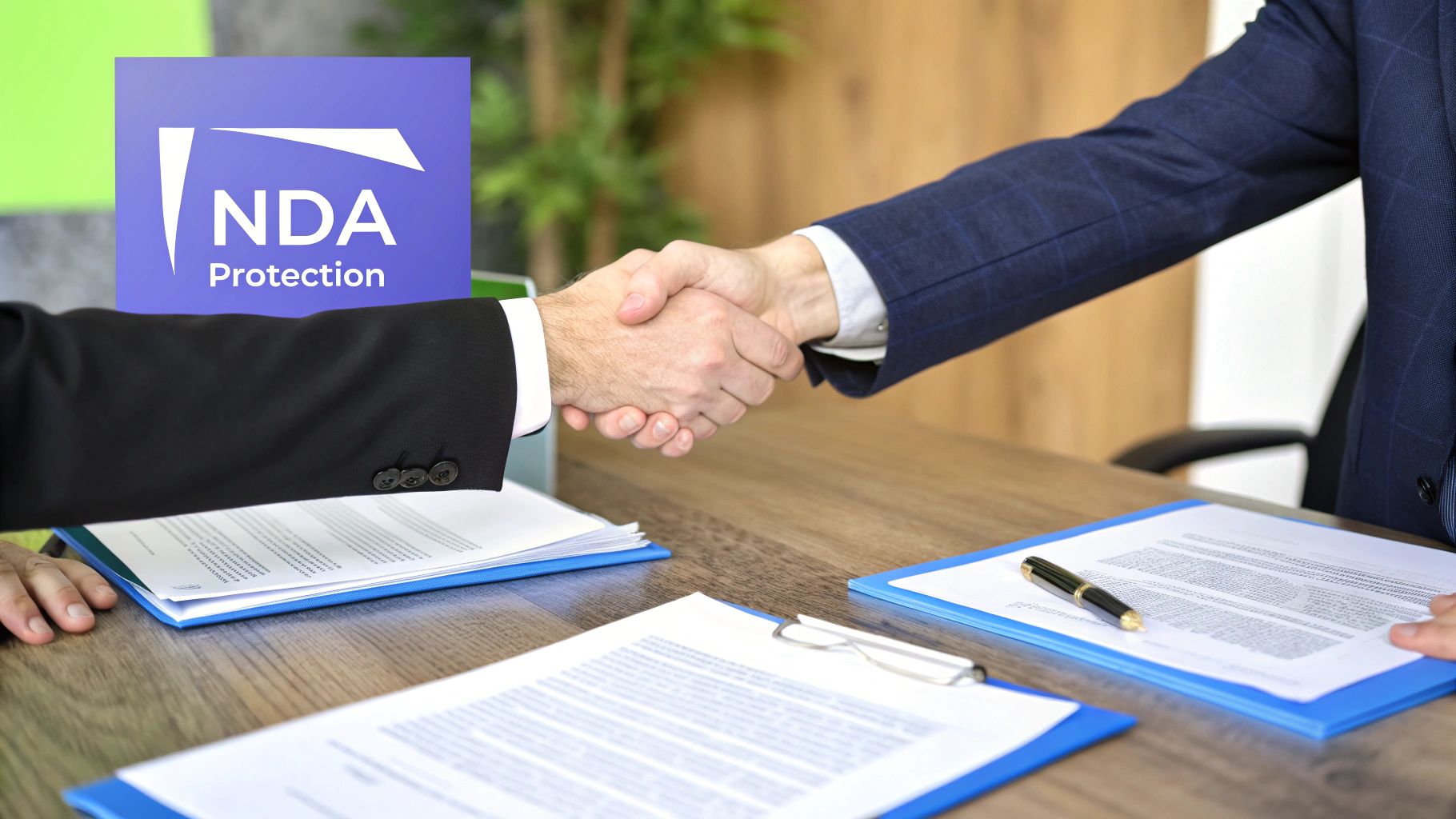
Legal contracts and high-tech security systems are essential, but they don't work in a vacuum. Your strongest line of defence is, and always will be, your team. When you foster a proactive, IP-savvy culture, every employee becomes a guardian of your most valuable assets. It creates an internal alarm system that technology alone can never replicate.
This isn’t about being restrictive; it’s about empowerment. When your team truly understands why intellectual property is so vital to the business's success and their own work, they become your greatest allies. The goal is to make safeguarding new creations a natural part of the daily workflow, not just another box to tick.
Creating Clear and Accessible IP Policies
First things first: you need to demystify intellectual property. Forget the dense, 100-page handbooks filled with legalese that no one ever reads. Your IP policy should be a clear, accessible, and practical guide that everyone can actually understand and use.
This document needs to plainly state the company's position on key issues and answer the questions your team will have.
Your policy must cover:
- Ownership: State clearly that any IP created by employees during their work belongs to the company. This prevents any ambiguity down the line.
- Confidentiality: Define what you consider confidential information—from client lists and project briefs to internal financial data—and explain the team's responsibility to protect it.
- Use of Third-Party Assets: Set out simple rules for using things like stock imagery, fonts, and open-source code. This helps you avoid accidentally infringing on someone else's copyright.
- Reporting Procedure: Create a straightforward process for team members to flag potential new IP (like a new tool or process they’ve developed) or report a suspected infringement they’ve spotted.
Think of this policy as a living document. It should be easy to find, regularly updated, and a core part of your onboarding process for every new hire, whether they're a full-time designer or a freelance developer.
The most effective IP policies aren't just rulebooks; they're resources. They should empower your team to make smart decisions with confidence, knowing they are acting in the best interest of the business.
Making these policies practical is what counts. Instead of just saying "protect client data," link to the specific procedures for proper data handling. Good policy underpins everything, especially when sensitive information is involved. Our guide on strategies for client data protection offers more insight into building these robust frameworks: https://infrazen.tech/client-data-protection/
Fostering Awareness Through Ongoing Training
A single mention during onboarding simply isn't enough. To build a lasting culture of IP awareness, protection needs to be an ongoing conversation, not a one-off event. Regular, engaging training sessions are the key to keeping these principles top-of-mind.
These sessions don't need to be dull, all-day seminars. Think short, focused "lunch and learn" meetings or interactive workshops.
Here are a few practical ideas:
- Real-World Scenarios: Discuss actual case studies of IP theft in the creative industry. This makes the risks feel tangible and immediate.
- Invention Spotting: Train your team to recognise when they might have created something valuable. A developer who automates a repetitive design task might have just created a patentable process without even realising it.
- Guest Speakers: Invite an IP lawyer to chat with your team. Hearing it from an outside expert can add weight and a fresh perspective on why these protections are so critical.
The real aim is to weave IP awareness into the very fabric of your company. When a designer instinctively checks the licence for a font, or a project manager ensures an NDA is signed before a kickoff call, you know the culture is working. This collective responsibility is how you truly safeguard your intellectual property from the inside out.
Proactively Monitoring and Enforcing Your Rights
So, you’ve registered your trademarks and your contracts are watertight. That’s a great start, but the work doesn’t stop there. In many ways, this is where it really begins.
Holding the rights to your IP is one thing; actively defending them is another entirely. This is the stage where all your careful preparation gets put to the test in the real world.
Think of proactive monitoring as keeping your eyes and ears open. It’s about constantly scanning the marketplace to make sure nobody is ripping off your brand name, copying your designs, or flogging counterfeit versions of your products. Without this vigilance, infringements can fly under the radar for months or even years, quietly chipping away at your reputation and revenue before you even know what’s happening.
This chart breaks down the relationship between different IP assets and their associated risks, showing exactly why monitoring is so vital.
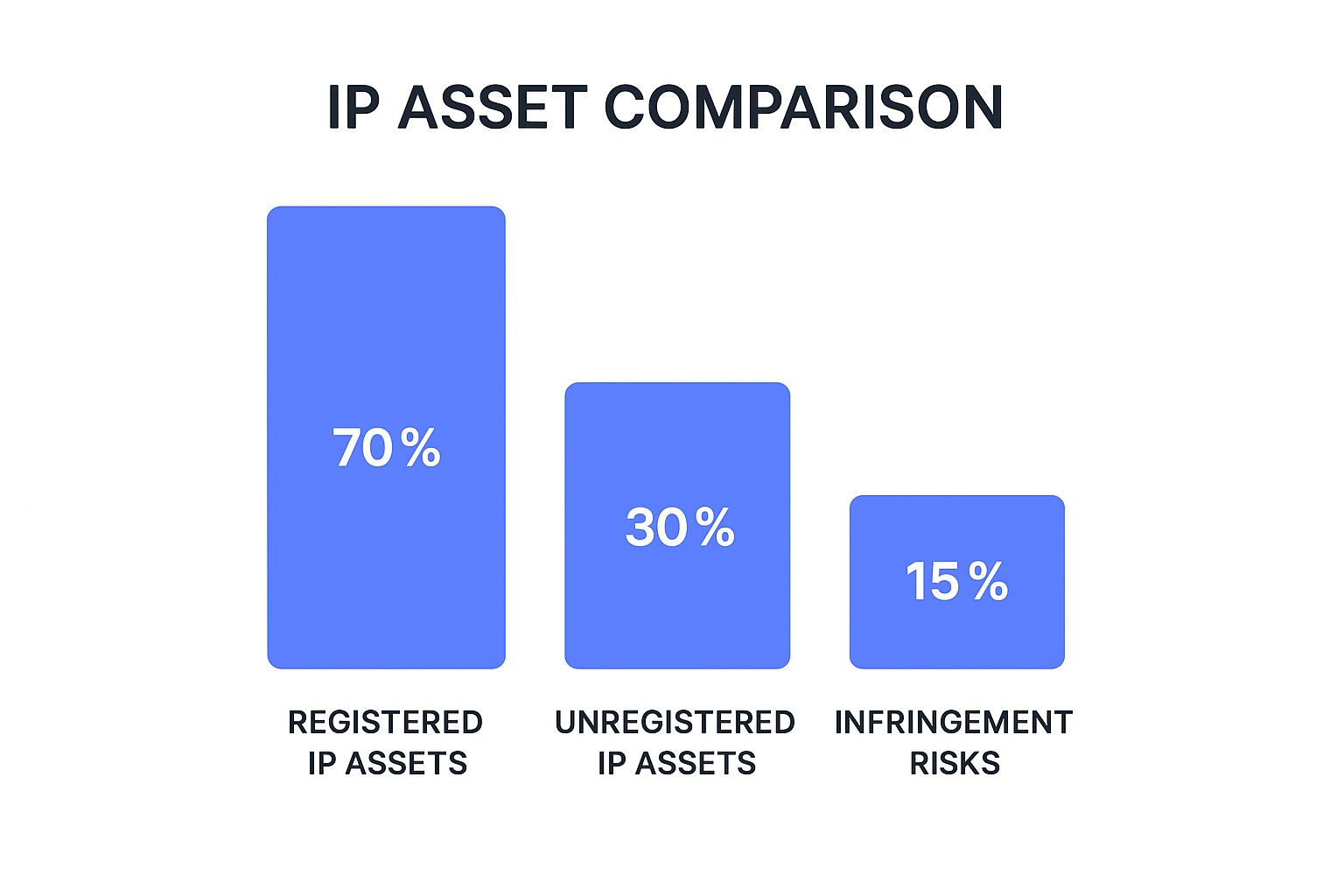
As you can see, the level of risk isn't always tied directly to formal registration. You need to stay alert across your entire portfolio of creative work.
Choosing Your Monitoring Approach
When it comes to monitoring, you’ve got a couple of options. Many businesses, especially smaller ones, start by doing it themselves. This usually involves setting up Google Alerts for your brand name, regularly searching e-commerce sites like Etsy or Amazon, and keeping a close watch on competitors’ social media feeds.
This hands-on approach can work for a while, particularly for a small studio with a handful of key assets to protect. The problem is, as your brand grows, it becomes incredibly time-consuming and frankly, a bit of a drag.
The real challenge with manual monitoring is its limited scope. You can only check the places you know about. Infringers often lurk in obscure corners of the internet, making them almost impossible to find without specialised tools.
This is where automated services come in. These platforms use technology to scan millions of websites, online marketplaces, and social media platforms for potential infringements, doing the heavy lifting for you.
Leveraging Automated Monitoring Tools
For any business serious about protecting its intellectual property, automated monitoring is a game-changer. These services cast a much wider net and deliver alerts straight to your inbox, saving you countless hours.
Some key services to look into:
- Trademark Watching Services: These platforms specifically monitor new trademark applications filed at intellectual property offices. They'll ping you if someone tries to register a name or logo that’s confusingly similar to yours, giving you a chance to object before it becomes a major headache.
- Online Brand Protection Platforms: These are more comprehensive. They scan for counterfeit products, unauthorised use of your branding on dodgy websites, and copycat social media profiles.
- Customs Enforcement: If you sell physical products, you can record your registered trademarks and designs with HM Revenue & Customs. This empowers border officials to identify and seize counterfeit goods before they even enter the UK market.
Using these tools shifts your posture from defensive to offensive. Instead of waiting to stumble upon a problem, you’re actively hunting for it.
In-House vs. Outsourced Enforcement
So, you’ve found an infringement. What next?
The first step is usually a simple "cease and desist" letter. This is a formal request sent to the infringer, clearly stating your rights and demanding they stop their illegal activity immediately. You can handle this yourself, but a letter from a solicitor often carries more weight and shows you mean business.
For more complex or stubborn cases, outsourcing to a specialist IP law firm or a brand protection agency is usually the smartest move. They have the experience to handle negotiations, file legal actions, and manage the entire enforcement process from start to finish. Yes, it costs money, but it frees you up to focus on what you do best: running your business.
Remember, a strong defence also relies on a secure internal environment. For more on this, check out our practical cyber security tips for creative businesses.
Ultimately, enforcement is a strategic decision. The path you choose—whether it’s a polite email or a full-blown legal challenge—will depend on the severity of the infringement and the potential damage to your brand. The key is to have a plan ready so you can act quickly and decisively when the time comes.
Answering Your Top IP Protection Questions
When you're trying to safeguard your creative work, a few common questions always seem to pop up. Getting straight, practical answers is key to making the right calls for your business. Let's tackle some of the queries we hear most often from creative studios.
A big one is simply understanding the difference between the main types of IP. Think of it like this: a patent is for an invention or a totally new process, like a unique software algorithm you've developed. A trademark, on the other hand, is all about your brand identity—it protects your name, logo, or slogan so no one else can cause confusion in the marketplace.
And then there's copyright. This one's great because it automatically covers original creative works—articles, music, photographs, designs—from the very moment you create them.
When Should We Go for International Protection?
This is a dilemma for any ambitious business: when is the right time to start registering your IP internationally? My advice is always to let your commercial footprint guide your protection strategy. There’s not much point paying to register a trademark in a country where you have no clients and no plans to expand.
The smart play is to lock down your rights in your home market first—for us, that’s the UK. Then, as you grow into new territories like the EU or North America, you can strategically expand your IP portfolio to match that growth.
For instance, a design studio based here in the UK should start by securing its trademark with the UK's Intellectual Property Office. It’s only when they begin actively winning work from clients in Germany or the US that they should look at using something like the Madrid System for broader international coverage.
This phased approach means your budget is spent where it counts, protecting your most valuable assets in your most valuable markets. It shifts IP registration from being just another costly admin task to a strategic investment that scales right alongside your business.
At InfraZen Ltd, we help creative businesses build secure, efficient IT systems that protect their most valuable work. We manage the technical complexity behind the scenes, so you can focus on creating without interruption. Discover how we can fortify your digital defences at https://infrazen.tech.
